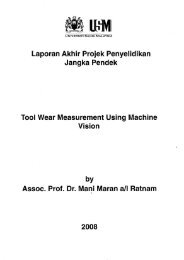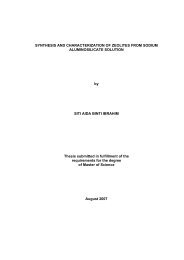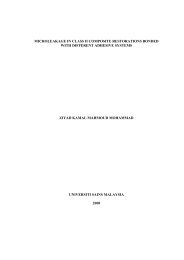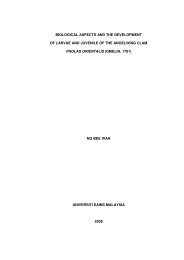A Knowledge-Based E-mail System Using Semantic ... - ePrints@USM
A Knowledge-Based E-mail System Using Semantic ... - ePrints@USM
A Knowledge-Based E-mail System Using Semantic ... - ePrints@USM
You also want an ePaper? Increase the reach of your titles
YUMPU automatically turns print PDFs into web optimized ePapers that Google loves.
RROCEEDINGS OF \VORLD AC.ADEMY OF SCIENCE~ENGINEERING A.ND TECHNOLOGY VOLUNIE 35 NOVEMBER 2008 ISSN 2070-3740<br />
disturbing arti.cle £0;:: me<br />
313 -<br />
ZOC8->JS=11<br />
~.he fore.s<br />
--~-----------------------------------------_:#P<br />
Fig. 5 Matching categories in the X1vIL file<br />
When a nlatch is found, the tag \vill refer to the<br />
tag to look for the identifier. The stores<br />
the Unified Resource Identifier \\rhich \vil1 be used to point to<br />
the specific e-<strong>mail</strong> and be linked to it. Thus, the content of<br />
these semantic.ally related e-<strong>mail</strong>s are reused when viewed by<br />
the user.<br />
B. ...4pplication Server<br />
As S0011 as an e-<strong>mail</strong> has been sent/posted:;> the e-<strong>mail</strong> server<br />
\vill be invoked. and the e-lnail's text will be senlantically<br />
processed. The IDs of each e-<strong>mail</strong> are also stored in the<br />
repository. Each e-<strong>mail</strong> posted by the user \vill be given two<br />
different IDs. The first ID is referred to KS-Mail-ID generat.ed<br />
by the KS-Mail server, while the second ID is the reference ill<br />
that functions as a pointer to the original e-<strong>mail</strong> \vhich the user<br />
is replying to (see Fig. 6).<br />
first E<strong>mail</strong><br />
KS-PvlaH..;lf): KS001:<br />
Re·fere=nce·-t~D:: nuB<br />
:Re-ply to First E<strong>mail</strong><br />
KS-P'>j4.ad-~liD: KSn02<br />
Refe-rence-J:D.:K-S{f01<br />
Fig. 6 KS-Mail-ID assignment Inechanisnl<br />
These t\.vo difIerent IDs are ilTIportant in the evaluation<br />
lllechanism as each e-<strong>mail</strong> ill will be used as a reference.<br />
\Nnenever an evaluation process is cOlnpleted:;> the evaluation<br />
scores in a rating tornl and comnlents \vill also be recorded<br />
and stored together. TIle process is repeated each time new<br />
evaluationsCOlTIe in, cOlnbining the details of the overall<br />
scores and total rating for each e-<strong>mail</strong>.<br />
V. CONCLUSION<br />
In this paper, we presented a combined approach to<br />
enhance an e-<strong>mail</strong> systeln through semantic categorization and<br />
rating. For this purpose, we have employed web technologies<br />
such as the semantic \veb, as well as ontology and natural<br />
language processing (NLP) techniques.<br />
By using selnantic teclmology, we allow knowledge to be<br />
acquired frOlTI the e-inail and categorized accordingly. This<br />
acquired knowledge is then stored and reused to promote<br />
knowledge sharing mnongst users. The semantic link<br />
subsequently provides easy access to related e-luails within<br />
the user's account. Naturally, users cannot view or link to e<br />
<strong>mail</strong> that is not within his/her KS-Mail ace·ount to ensure<br />
security and privacy.<br />
\\tl1at is exciting is that we have observed that KS-Mail<br />
effectively brings older e-lnails to the attention of the user via<br />
the semantic links that are created. This happens whenever a<br />
new e-lnail is created or received. This opens a whole new e<br />
<strong>mail</strong>ing experience for the user fioln a knowledge<br />
management point of view. The user is now able to calTY our<br />
kno\vledge acquisition, organization and reuse just by using<br />
the KS-Mail system.<br />
In sUlnmary, the value added concept of KS-Mail is the<br />
franle\¥ork that highlights the ilnportance of the e-<strong>mail</strong>'s<br />
content. We also emphasize the significance of knowledgerich<br />
e-<strong>mail</strong> through rating and searching mechanisllls.<br />
In the fut.ure, we·hope to expand the features ofKS-Mail to<br />
incorporate semantic blogging [7]. In this future enhancement,<br />
it is hoped that an improved ontology mapping process can be<br />
enlployed. Through the selnantic blogging exercise, it may<br />
even be possible to tease tacit knowledge froln experts <br />
which is something that is much desired in a knowledge<br />
manageillent context.<br />
REFERENCES<br />
[1] A. Mohd Kassinl and Y.-N. Cheah, H<strong>Using</strong> <strong>Semantic</strong> Web.. Ontologies<br />
and Blogs for <strong>Knowledge</strong> Identification, Organisation and Reuse,'~<br />
International Conference on Electrical Engineering and InfonnaliL'S<br />
2007 (ICEEI2007), Bandung, Indonesia. June 17-19, 2007, pp. 691<br />
694.<br />
[2] K.G. Linl and Y.-N. Cheah, "Sharing, Evaluating and Organizing E<br />
1vlail: The KM-I\.1ail A.pproach," The 3 rd International Conference on<br />
information Technology in _A.sia~ Sarawak, Malaysia, July 17-18, 2003,<br />
pp.112-117.<br />
[3] L. McDowell.. O. Etzioni, A. Halevy, and H. Levy.. ~;'<strong>Semantic</strong> e-<strong>mail</strong>,"<br />
Proceedings of the 13th international conference on ~Vorld PVide<br />
r¥eb(Tf/JV~V '04}. New York.. NY, USA, May 2004.. pp. 244-254.<br />
[4] S. Scen'i~ B. Davis. and S. Handschuh, Hlmproving E-Inail Conversation<br />
Efficiency through Selnantically Enhanced E-lnail," Proceedings ofthe<br />
18th International Conference on Database Clnd E~'rperr <strong>System</strong>s<br />
Applications (DEX4 2007}, Regensburg, Gemlany, Septenlber 3-7,<br />
2007,pp.490-494.<br />
[5] !vI. Kassoff, C. Peine, LJv1. Zen, and}.lI. Genesereth. ~'<strong>Semantic</strong> E-<strong>mail</strong><br />
Addressing: Sending E-<strong>mail</strong> to People, NotStrings,"AA.AI 2006 Fall<br />
Symposium, Washington~ DC~ October 13-15,2006.<br />
[6] P. Wan"en, '''<strong>Knowledge</strong> Management and the Selnantic Web: From<br />
Scenario to Technology," IEEE Intelligent <strong>System</strong>s) 2006, Vol. 21.~ pp.<br />
53-59.<br />
[7] Y.-N. Cheah, "'Enhancing Groupw'are for K110\¥ledge Management,"<br />
F~fth International C01?(erence on Infonnation Technology in Asia<br />
(LiTA 2007), Sanl\¥ak, Malaysia, July 9-12,2007, pp. 145-150.<br />
[8] M. McShane, S. Nirenburg and S. Beale, "An hnplemented, Integrative<br />
Approach to Ontology-<strong>Based</strong> NLP and Interlingua," Working Paper 06<br />
05. Institute for Language and Infornlation Technologies, University of<br />
1v1aryland Baltimore County, USA, March 8, 2005.<br />
P\VASET '/OLU1-1E 35 NOVElY1BER 2008 ISSN 2070-3740 106 © 2008 WASET.ORG

















